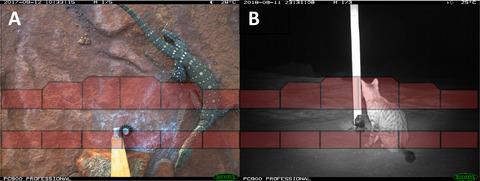当前位置:
X-MOL 学术
›
Remote Sens. Ecol. Conserv.
›
论文详情
Our official English website, www.x-mol.net, welcomes your
feedback! (Note: you will need to create a separate account there.)
The effect of camera orientation on the detectability of wildlife: a case study from north‐western Australia
Remote Sensing in Ecology and Conservation ( IF 3.9 ) Pub Date : 2020-04-16 , DOI: 10.1002/rse2.158 Harry A. Moore 1, 2 , Leonie E. Valentine 2 , Judy A. Dunlop 3 , Dale G. Nimmo 1
Remote Sensing in Ecology and Conservation ( IF 3.9 ) Pub Date : 2020-04-16 , DOI: 10.1002/rse2.158 Harry A. Moore 1, 2 , Leonie E. Valentine 2 , Judy A. Dunlop 3 , Dale G. Nimmo 1
Affiliation

|
Camera traps are increasingly used to survey and monitor rare or cryptic species, yet few studies consider how camera orientation influences species detectability, among other metrics such as total independent detections and likelihood of missing detections. We used these measures to compare the performance of vertically and horizontally orientated camera traps at 46 sites spread over 10 000 km2 in north‐west Australia. Data were collected for four taxa, including northern quolls (Dasyurus hallucatus), Rothschild's rock‐wallabys (Petrogale rothschildi), feral cats (Felis catus) and varanids (Varanus spp.). Metrics compared included probability of species presence/absence, total independent detections recorded and likelihood of cameras missing or recording nightly detections. We found camera orientation did not impact camera performance across any metric for northern quolls. By contrast, we found horizontal cameras were more efficient at detecting feral cats and Rothschild's rock wallabies. They also recorded more detections and were less likely to miss detections than vertical cameras for these species. For varanids, vertical cameras outperformed horizontal cameras across all metrics. Studies that use vertical cameras to collect image data better suited for species or individual identification should consider how target species detectability may be compromised by having a reduced detection zone size. However, horizontally orientated cameras may not always be superior to vertically orientated cameras in terms of species detectability, particularly for laterally compressed species such as lizards.
中文翻译:

摄影机定位对野生生物可检测性的影响:以澳大利亚西北部地区为例
相机陷阱越来越多地用于调查和监视稀有或隐秘物种,但是很少有研究考虑相机方向如何影响物种可检测性,以及诸如完全独立检测和丢失检测的可能性之类的其他指标。我们使用这些措施来比较澳大利亚西北地区分布在10000 km 2的46个站点上垂直和水平方向的相机陷阱的性能。收集了四个类群的数据,包括北洋壳s(Dasyurus hallucatus),罗斯柴尔德的岩袋鼠(Petrogale rothschildi),野猫(Felis catus)和瓦拉尼斯(Varanus)spp。)。比较的指标包括物种存在/不存在的概率,记录的总独立检测量以及相机丢失或记录夜间检测量的可能性。我们发现相机方位不会影响任何北部度量标准的相机性能。相比之下,我们发现卧式摄像头在检测野猫和罗斯柴尔德的岩袋鼠方面更有效。与垂直相机相比,他们还记录了更多的检测物,并且错过这些检测物的可能性较小。对于varanids,在所有指标上,立式摄像机的性能均优于卧式摄像机。使用垂直相机收集更适合物种或个体识别的图像数据的研究应考虑通过减小检测区的大小来损害目标物种的可检测性。然而,
更新日期:2020-04-16
中文翻译:

摄影机定位对野生生物可检测性的影响:以澳大利亚西北部地区为例
相机陷阱越来越多地用于调查和监视稀有或隐秘物种,但是很少有研究考虑相机方向如何影响物种可检测性,以及诸如完全独立检测和丢失检测的可能性之类的其他指标。我们使用这些措施来比较澳大利亚西北地区分布在10000 km 2的46个站点上垂直和水平方向的相机陷阱的性能。收集了四个类群的数据,包括北洋壳s(Dasyurus hallucatus),罗斯柴尔德的岩袋鼠(Petrogale rothschildi),野猫(Felis catus)和瓦拉尼斯(Varanus)spp。)。比较的指标包括物种存在/不存在的概率,记录的总独立检测量以及相机丢失或记录夜间检测量的可能性。我们发现相机方位不会影响任何北部度量标准的相机性能。相比之下,我们发现卧式摄像头在检测野猫和罗斯柴尔德的岩袋鼠方面更有效。与垂直相机相比,他们还记录了更多的检测物,并且错过这些检测物的可能性较小。对于varanids,在所有指标上,立式摄像机的性能均优于卧式摄像机。使用垂直相机收集更适合物种或个体识别的图像数据的研究应考虑通过减小检测区的大小来损害目标物种的可检测性。然而,









































 京公网安备 11010802027423号
京公网安备 11010802027423号